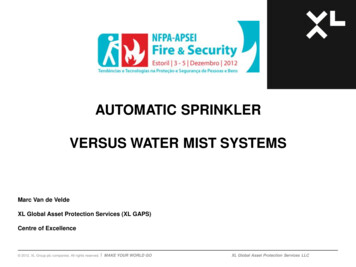![First Revision No. 8978-NFPA 70-2018 [ Global Input ]](/img/38/70-a2020-nec-p07-fd-frstatements.jpg)
Transcription
National Fire Protection Association mLaunch?id /TerraView/.First Revision No. 8978-NFPA 70-2018 [ Global Input ]Change Title of Article 555 to Marinas, Boatyards, Floating Buildings and Commercial andNoncommercial Docking FacilitiesAdd the following Informational Note below title.Informational Note: Text that is followed by a reference in brackets has been extracted from NFPA 303 -2016,Fire Protection Standard for Marinas and Boatyards, and NFPA 307-2016, Standard for the Construction andFire Protection of Marine Terminals, Piers, and Wharves. Only editorial changes were made to the extractedtext to make it consistent with this Code.Merge Article 553 and Article 555.See attached word document.Supplemental InformationFile NameFINAL Article 553-555 Merged.docxDescriptionAll changes to 555 were done through FR's in 555. Trackchanges does not show these changes. Everything is justmoved with the exception of the highlighted sections. Thosesections had slight modifications to account for the merging ofthe two articles.Approved Submitter Information VerificationSubmitter Full Name: NEC-CMP Panel 07Organization:[ Not Specified ]Street Address:City:State:Zip:Submittal Date:Wed Jan 24 15:16:51 EST 2018Committee Statement and Meeting NotesCommitteeStatement:Delete Article 553 and add “floating buildings” into the title of Article 555. Due to the electrical safetyhazards, and the electrical infrastructure being similar in nature. The addition of “floating buildings” toArticle 555 will enhance electrical safety and usability of the NEC. Also, add an Informational Note toprovide information to other NFPA standards that could be a potential source and to note where codelanguage has been extracted.ResponseMessage:Public Input No. 3274-NFPA 70-2017 [Article 553]Public Input No. 3273-NFPA 70-2017 [Article 555]Editorial CommentClick here1 of 13/7/2018, 11:11 AM
Article 555Marinas, Boatyards, Floating Buildings and Commercial andNoncommercial Docking FacilitiesInformational Note: Text that is followed by a reference inbrackets has been extracted from NFPA 303-2016, FireProtection Standard for Marinas and Boatyards, and NFPA307-2016, Standard for the Construction and Fire Protection ofMarine Terminals, Piers, and Wharves. Only editorial changeswere made to the extracted text to make it consistent with thisCode.Commented [RH1]: PI 3273 Commented [RH2]: PI 2893 Part I. General555.1 Scope.This article covers the installation of wiring and equipment in theareas comprising fixed or floating piers, wharves, docks, floatingbuildings and other areas in marinas, boatyards, boat basins,boathouses, yacht clubs, boat condominiums; docking facilitiesassociated with one-family dwellings, two-family dwellings,multifamily dwellings, and residential condominiums; any multipledocking facility or similar occupancies; and facilities that are used,or intended for use, for the purpose of repair, berthing, launching,storage, or fueling of small craft and the moorage of floatingbuildings.Informational Note No.1: See NFPA 303-2011, Fire ProtectionStandard for Marinas and Boatyards, for additional information.Informational Note No. 2: Where boats, floating buildings,docks, etc. are connected to a source of electric supply,Commented [RH3]: PI 3273 Commented [RH4]: PI 2203
hazardous voltages and currents may create serious safetyconcerns.555.2 Definitions. The definitions in this section shall apply onlywithin this article.Commented [RH5]: PI 2203 Commented [RH6]: PI 2228, 1910 Berth.The water space to be occupied by a boat or other vesselalongside or between bulkheads, piers, piles, fixed and floatingdocks, or any similar access structure. (See also Slip.) [NFPA 3033.3.1]Commented [RH7]: PI 2488 Boatyard.A facility used for constructing, repairing, servicing, hauling fromthe water, storing (on land and in water), and launching of boats.[303 3.3.2]Commented [RH8]: PI 2492 Bulkhead.A vertical structural wall, usually of stone, timber, metal, concrete,or synthetic material, constructed along, and generally parallel to,the shoreline to retain earth as an extension of the upland, andoften to provide suitable water depth at the waterside face. [3033.3.4]Commented [RH9]: PI 2493 Crane.A mechanical device used for lifting or moving boats. [303 3.3.5]Commented [RH10]: PI 2494 Docking Facility.A covered or open, fixed or floating structure that provides accessto the water and to which boats are secured. [303 3.3.7]Commented [RH11]: TIA 1348 Electrical Datum Plane.A specified distance above a water level above which electricalequipment can be installed and electrical connections can bemade.Commented [RH12]: PI 2898
Floating Building.A building unit, as defined in Article 100, that floats on water, ismoored in a permanent location, and has a premises wiringsystem served through connection by permanent wiring to anelectrical supply system not located on the premises.Commented [RH13]: Moved from 553.2 Marina.A facility, generally on the waterfront, that stores and servicesboats in berths, on moorings, and in dry storage or dry stackstorage. [303 3.3.12]Commented [RH14]: PI 2496 Marina Power Outlet.An enclosed assembly that can include equipment such asreceptacles, circuit breakers, fused switches, fuses, a watt-hourmeter(s), panelboards, and monitoring means identified formarina use. [303 3.3.13]Commented [RH15]: Changed “Marine” to “Marina”PI 2509 Monorail.Overhead track and hoist system for moving material around theboatyard or moving and launching boats. [303 3.3.15]Commented [RH17]: PI 2497 Mooring(s).Any place where a boat is wet stored or berthed. [303 3.3.16]Commented [RH18]: PI 2498 Pier.A structure extending over the water and supported on a fixedfoundation (fixed pier), or on flotation (floating pier), that providesaccess to the water. [303 3.3.17]Commented [RH19]: PI 2500 Pier, Fixed.Pier constructed on a permanent, fixed foundation, such as onpiles, that permanently establishes the elevation of the structuredeck with respect to land. [303 3.3.17]Commented [RH20]: PI 2501 Commented [RH16]: PI 1235
Pier, Floating.Pier designed with inherent flotation capability that allows thestructure to float on the water surface and rise and fall with waterlevel changes. [303 3.3.18]Commented [RH21]: PI 2502 Shore Power.The electrical equipment required to power a floating vesselincluding but not limited to the receptacle and cords.Commented [RH22]: PI 2506 Slip.A berthing space between or adjacent to piers, wharves, or docks;the water areas associated with boat occupation. (See alsoBerth.) [303 3.3.20]Commented [RH23]: PI 2504 Storage, Dry Stack.A facility, either covered or uncovered, constructed of horizontaland vertical structural members designed to allow placement ofsmall boats in defined slots arranged both horizontally andvertically. [303 3.23.2]Commented [RH24]: PI 2505 Wharf.A structure at the shoreline that has a platform built along andparallel to a body of water with either an open deck or asuperstructure. [307 3.3.24]Commented [RH25]: PI 2671 555.3 Electrical Datum Plane Distances.Commented [RH26]: New sectionPI 2534 (A) Floating Piers. The electrical datum plane for floating piersand boat landing stages that are (1) installed to permit rise andfall response to water level, without lateral movement, and (2) thatare so equipped that piers and landing stages can rise to thedatum plane established for 555.3(B) or (C), shall be a horizontalplane 762 mm (30 in.) above the water level at the floating pier orboat landing stage and a minimum of 305 mm (12 in.) above thelevel of the deck.
(B) Areas Subject to Tidal Fluctuations. In land areas subjectto tidal fluctuation, the electrical datum plane shall be a horizontalplane that is 606 mm (2 ft) above the highest tide level for thearea occurring under normal circumstances, based on the highesthigh tide.(C) Areas Not Subject to Tidal Fluctuations. In land areas notsubject to tidal fluctuation, the electrical datum plane shall be ahorizontal plane that is 606 mm (2 ft) above the highest waterlevel for the area occurring under normal circumstances.555.4 Location of Service Equipment.Commented [RH27]: Old 555.7 / 553.4Language edited to be applicable to revised scopeThe service equipment for a floating building, docks, or marinasshall be located adjacent to the structure, but not on or in, thestructure itself or any other floating structure.555.5 Maximum Voltage.Pier power distribution systems shall not exceed 250 volts phaseto phase. Pier power distribution systems, where qualifiedpersonnel service the equipment under engineering supervision,are permitted to exceed 250 volts but these systems shall notexceed 600 volts.555.6 Load Calculations for Service and Feeder Conductors.General lighting and other loads shall be calculated in accordancewith Part III of Article 220, and, in addition, the demand factors setforth in Table 555.6 shall be permitted for each service and/orfeeder circuit supplying receptacles that provide shore power forboats. These calculations shall be permitted to be modified asindicated in notes (1) and (2) to Table 555.6. Where demandCommented [RH28]: Old 555.4 (was called DistributionSystem)PI 2531 Commented [RH29]: Old 555.12
factors of Table 555.6 are applied, the demand factor specified in220.61(B) shall not be permitted.Informational Note: These demand factors may be inadequatein areas of extreme hot or cold temperatures with loadedcircuits for heating, air-conditioning, or refrigerating equipment.Table 555.6 Demand FactorsNumber of Shore PowerReceptaclesSum of the Rating of theReceptacles 05051–7040 7130Notes:1. Where shore power accommodations provide tworeceptacles specifically for an individual boat slip and thesereceptacles have different voltages (for example, one 30ampere, 125 volt and one 50 ampere, 125/250 volt), only thereceptacle with the larger kilowatt demand shall be required tobe calculated.2. If the facility being installed includes individual kilowatt-hoursubmeters for each slip and is being calculated using thecriteria listed in Table 555.6, the total demand amperes may bemultiplied by 0.9 to achieve the final demand amperes.
555.7 Transformers.Commented [RH30]: Old 555.5(A) General. Transformers and enclosures shall be identified forwet locations. The bottom of transformer enclosures shall not belocated below the electrical datum plane.Commented [RH31]: PI 1236, 1237 (B) Replacements. Transformers and enclosures shall beidentified for wet locations where replacements are made.Commented [RH32]: PI 1368 555.8 Marine Hoists, Railways, Cranes, and Monorails.Commented [RH33]: Old 555.23Motors and controls for marine hoists, railways, cranes, andmonorails shall not be located below the electrical datum plane.Where it is necessary to provide electric power to a mobile craneor hoist in the yard and a trailing cable is utilized, it shall be alisted portable power cable rated for the conditions of use and beprovided with an outer jacket of distinctive color for safety.555.9 Boat Hoists.Commented [RH34]: PI 2563 GFCI protection for personnel shall be provided for outlets notexceeding 240 volts that supply boat hoists installed at dwellingunit docking facilities.555.10 Signage.Permanent safety signs shall be installed to give notice ofelectrical shock hazard risks to persons using or swimming near adocking facility, boatyard, or marina and shall comply with all ofthe following:(1) The signage shall comply with 110.21(B)(1) and be ofsufficient durability to withstand the environment.(2) The signs shall be clearly visible from all approaches to amarina, docking facility, or boatyard facility.Commented [RH35]: Old 555.24Commented [RH36]: PI 4344
(3) The signs shall state “WARNING — POTENTIAL SHOCKHAZARD — ELECTRICAL CURRENTS MAY BE PRESENT INTHE WATER.”555.11 Motor Fuel Dispensing Stations — Hazardous(Classified) Locations.Commented [RH37]: Old 555.21Electrical wiring and equipment located at or serving motor fueldispensing locations shall comply with Article 514 in addition tothe requirements of this article.555.12 Repair Facilities — Hazardous (Classified) Locations.Commented [RH38]: Old 555.22Electrical wiring and equipment located at facilities for the repairof marine craft containing flammable or combustible liquids orgases shall comply with Article 511 in addition to the requirementsof this article.Part II. Marinas, Boatyards, and Docking Facilities555.30 Electrical Connections.Commented [RH39]: Old 555.9(A) Floating Piers. Electrical connections shall be located at least305 mm (12 in.) above the deck of a floating pier. Conductorsplices, within junction boxes identified for wet locations, utilizingsealed wire connector systems listed and identified forsubmersion shall be required for floating piers where locatedabove the waterline but below the electrical datum plane .Commented [RH40]: PI 1369 (B) Fixed Piers. All electrical connections shall be located at least305 mm (12 in.) above the deck of a fixed pier but shall not belocated below the electrical datum plane.Commented [RH43]: PI 1369 Commented [RH41]: PI 1239, 1240, 1369, 2788 Commented [RH42]: PI 1369, 2788
(C) Replacements. Replacement electrical connections shall belocated at least 305 mm (12 in.) above the deck of a floating pier.Conductor splices, within identified junction boxes, utilizing sealedwire connector systems listed and identified for submersion shallbe required where located above the waterline but below theelectrical datum plane for floating piers.Commented [RH44]: PI 1369, 2788 555.31 Electrical Equipment Enclosures.Commented [RH45]: Old 555.10(A) Securing and Supporting. Electrical equipment enclosuresinstalled on piers above deck level shall be securely andsubstantially supported by structural members, independent ofany conduit connected to them. If enclosures are not attached tomounting surfaces by means of external ears or lugs, the internalscrew heads shall be sealed to prevent seepage of water throughmounting holes.(B) Location. Electrical equipment enclosures on piers shall belocated so as not to interfere with mooring lines.555.32 Circuit Breakers, Switches, Panelboards, and MarinaePower Outlets.Circuit breakers and switches installed in gasketed enclosuresshall be arranged to permit required manual operation withoutexposing the interior of the enclosure. All such enclosures shallbe arranged with a weep hole to discharge condensation.555.33 Receptacles.Receptacles shall be mounted not less than 305 mm (12 in.)above the deck surface of the pier and not below the electricaldatum plane on a fixed pier.(A) Shore Power Receptacles.Commented [RH46]: Old 555.11Change “Marine” to “Marina” to align with other suchchangesCommented [RH47]: Old 555.19
(1) Enclosures. Receptacles intended to supply shore power toboats shall be enclosed in listed marina power outlets, enclosureslisted for wet locations, or shall be installed in listed enclosuresprotected from the weather. The integrity of the assembly shallnot be affected when the receptacles are in use with any type ofbooted or nonbooted attachment plug/cap inserted.Commented [RH48]: PI 2513 (2) Strain Relief. Means shall be provided where necessary toreduce the strain on the plug and receptacle caused by the weightand catenary angle of the shore power cord.(3) Branch Circuits. Each single receptacle that supplies shorepower to boats shall be supplied from a marina power outlet orpanelboard by an individual branch circuit of the voltage class andrating corresponding to the rating of the receptacle.Commented [RH49]: PI 2513 Informational Note: Supplying receptacles at voltages otherthan the voltages marked on the receptacle may causeoverheating or malfunctioning of connected equipment, forexample, supplying single-phase, 120/240-volt, 3-wire loadsfrom a 208Y/120-volt, 3-wire source.(4) Ratings. Shore power for boats shall be provided by singlereceptacles rated not less than 30 amperes.Informational Note: For locking- and grounding-typereceptacles for auxiliary power to boats, see NFPA 303-2011,Fire Protection Standard for Marinas and Boatyards.(a) Receptacles rated 30 amperes and 50 amperes shall be ofthe locking and grounding type.Informational Note: For various configurations and ratings oflocking- and grounding-type receptacles and caps, seeANSI/NEMA WD 6-2016, Wiring Devices – DimensionalSpecifications.Commented [RH50]: PI 722
(b) Receptacles rated 60 amperes or higher shall be of the pinand sleeve type.Informational Note: For various configurations and ratings ofpin and sleeve receptacles, see ANSI/UL 1686, UL Standardfor Safety Pin and Sleeve Configurations.(B) Other Than Shore Power.(1) Ground-Fault Circuit-Interrupter (GFCI) Protection forPersonnel. Receptacles in other locations shall be protected inaccordance with 210.8.(2) Marking. Receptacles other than those supplying shorepower to boats shall be permitted to be housed in marina poweroutlets with the receptacles that provide shore power to boats,provided they are marked to clearly indicate that they are not tobe used to supply power to boats.Commented [RH51]: PI 1370, 2562, 3358 Commented [RH52]: PI 2513 (C) Replacement Receptacles. The requirements in 555.33 shallapply to the replacement of marina receptacles.Commented [RH53]: PI 1373, 238 555.34 Wiring Methods and Installation.Commented [RH54]: Old 555.13(A) Wiring Methods.(1) General. Wiring methods of Chapter 3 shall be permittedwhere identified for use in wet locations.(2) Portable Power Cables. Extra-hard usage portable powercables rated not less than 75 C (167 F), 600 volts; listed for bothwet locations and sunlight resistance; and having an outer jacketrated to be resistant to temperature extremes, oil, gasoline,ozone, abrasion, acids, and chemicals shall be permitted asfollows:
(1) As permanent wiring on the underside of piers (floating orfixed)(2) Where flexibility is necessary as on piers composed offloating sections(3) Temporary Wiring.Temporary wiring, except as permitted by Article 590, shall not beused to supply power to boats.(B) Installation.(1) Overhead Wiring. Overhead wiring shall be installed to avoidpossible contact with masts and other parts of boats being movedin the yard.Conductors and cables shall be routed to avoid wiring closer than6.0 m (20 ft) from the outer edge or any portion of the yard thatcan be used for moving vessels or stepping or unstepping masts.(2) Outdoor Branch Circuits and Feeders. Multiple feeders andbranch circuits shall be permitted. Clearances for overheadbranch circuit and feeder wiring in locations of the boatyard otherthan those described in 555.34(B)(1) shall be located not lessthan 5.49 m (18 ft) above grade. Only Part I of Article 225 shallapply to marina installations.(3) Portable Power Cables.(a) Where portable power cables are permitted by 555.34(A)(2),the installation shall comply with the following:(1) Cables shall be properly supported.(2) Cables shall be located on the underside of the pier.Commented [RH55]: PI 1241 Commented [RH56]: PI 1241 Commented [RH57]: Deleted old (3) Wiring Over andUnder Navigable WaterPI 1242
(3) Cables shall be securely fastened by nonmetallic clips tostructural members other than the deck planking.(4) Cables shall not be installed where subject to physicaldamage.(5) Where cables pass through structural members, they shall beprotected against chafing by a permanently installed oversizedsleeve of nonmetallic material.(b) Where portable power cables are used as permitted in555.34(A)(2)(2), there shall be a junction box of corrosionresistant construction with permanently installed terminal blockson each pier section to which the feeder and feeder extensionsare to be connected. A listed marina power outlet employingterminal blocks/bars shall be permitted in lieu of a junction box.Metal junction boxes and their covers, and metal screws andparts that are exposed externally to the boxes, shall be ofcorrosion-resistant materials or protected by material resistant tocorrosion.Commented [RH58]: PI 1244 Commented [RH59]: PI 2511 (4) Protection. Rigid metal conduit, reinforced thermosettingresin conduit (RTRC) listed for aboveground use, or rigid polyvinylchloride (PVC) conduit suitable for the location, shall be installedto protect wiring above decks of piers and landing stages andbelow the enclosure that it serves. The conduit shall be connectedto the enclosure by full standard threads or fittings listed for use indamp or wet locations, as applicable.555.35 Ground-Fault Protection of Equipment (GFPE) andGround-Fault Current-Interrupter (GFCI) Protection.(A) Ground-Fault Protection. For other than floating buildings,ground-fault protection for docking facilities shall be provided inaccordance with the following:Commented [RH60]: Originally 555.3PI 1611, 2549, 2791, 2793, 3209, 3606
(1) Receptacles Providing Shore Power. Receptacles installedin accordance with 555.33(A) shall have individual ground-faultprotection of equipment (GFPE) set to open at currents notexceeding 30 mA.(2) Ground-Fault Circuit-Interrupter (GFCI) Protection forPersonnel. All 125-volt, single phase 15- and 20-amperereceptacles, for other than shore power, shall be protected inaccordance with 555.33(B).(3) Feeder and Branch Circuit Conductors With GFPE. Feederand branch circuit conductors that are installed on dockingfacilities shall be provided with ground-fault protection ofequipment (GFPE) set to open at currents not exceeding 100mA. Coordination with downstream ground-fault protection ofequipment (GFPE) shall be permitted at the feeder overcurrentprotective device.(B) Leakage Current Measurement Device. Where more thanthree receptacles supply shore power to boats, a leakage currentmeasurement device shall be available and be used to determineleakage current from each boat that will utilize shore power.Informational Note No. 1: Leakage current measurement willprovide the capability to determine when an individual boat hasdefective wiring or other problems contributing to hazardousvoltage and current. The use of a test device will allow thefacility operator to identify a boat that is creating problems. Insome cases, a single boat may cause an upstream GFPEdevice protecting a feeder to operate even though multipleboats are supplied from the same feeder. The use of a testdevice will help the facility operator prevent a particular boatfrom contributing to hazardous voltage and current in themarina area.
Informational Note No. 2: An annual test of each boat with theleakage current measurement device is a prudent step towardsdetermining if a boat has defective wiring that may becontributing hazardous voltage and current. Where the leakagecurrent measurement device reveals that a boat is contributinghazardous voltage and current, repairs should be made to theboat before it is permitted to utilize shore power.555.36 Disconnecting Means for Shore Power Connection(s).Commented [RH61]: Old 555.17Disconnecting means shall be provided to isolate each boat fromits supply connection(s).(A) Type. The disconnecting means shall consist of a circuitbreaker, switch, or both, and shall be properly identified as towhich receptacle it controls.(B) Location. The disconnecting means shall be readilyaccessible, located not more than 762 mm (30 in.) from thereceptacle it controls, and shall be located in the supply circuitahead of the receptacle. Circuit breakers or switches located inmarina power outlets complying with this section shall bepermitted as the disconnecting means.Commented [RH62]: PI 2512 555.37 Equipment Grounding Conductor.Commented [RH63]: Old 555.15(A) Equipment to Be Connected to Equipment GroundingConductor.Commented [RH64]: PI 2032 The following items shall be connected to an equipmentgrounding conductor run with the circuit conductors in the sameraceway, cable, or trench:(1) Metal boxes, metal cabinets, and all other metal enclosures(2) Metal frames of utilization equipment
(3) Grounding terminals of grounding-type receptacles(B) Type of Equipment Grounding Conductor.The equipment grounding conductor shall be an insulatedconductor with a continuous outer finish that is either green orgreen with one or more yellow stripes. The equipment groundingconductor of Type MI cable shall be permitted to be identified atterminations. For conductors larger than 6 AWG, or wheremulticonductor cables are used, re-identification of conductorsallowed in 250.119(A)(2)b. and (A)(2)c. or 250.119(B)(2) and(B)(3) shall be permitted.(C) Size of Equipment Grounding Conductor.The insulated equipment grounding conductor shall be sized inaccordance with 250.122 but not smaller than 12 AWG.(D) Branch-Circuit Equipment Grounding Conductor.The insulated equipment grounding conductor for branch circuitsshall terminate at a grounding terminal in a remote panelboard orthe grounding terminal in the main service equipment.(E) Feeder Equipment Grounding Conductors.Where a feeder supplies a remote panelboard, an insulatedequipment grounding conductor shall extend from a groundingterminal in the service equipment to a grounding terminal in theremote panelboard.555.38 Equipotential Bonding(A) Performance. The equipotential bonding required by thissection shall be installed to reduce voltage gradients in the marinadock area.Commented [RH65]: New sectionPI 2792, 2423, 1372
(B) Bonded Parts. The following parts shall be bonded togetherusing solid copper conductors; insulated, covered, or bare; notsmaller than 8 AWG. Connections to bonded parts shall be madein accordance with 250.8. An 8 AWG or larger solid copperbonding conductor provided to reduce voltage gradients on themarina dock shall not be required to be extended or attached toremote panelboards, service equipment, or electrodes.(1) Electrical Equipment. Metal parts of electrical equipmentinstalled on the boat dock with the exception of double-insulatedmotors shall be bonded together.(2) Metallic Components. All metallic parts of the dock structureshall be bonded together.(3) Fixed Metal Parts or Fittings. All fixed metal parts including,but not limited to, metal sheathed cables and raceways, metalpiping, metal awnings, metal fences, metal ladders, metal framesof diving boards or slides, metal tanks, metal fittings lager than100 mm (4 in.) and attached to the dock shall be bonded together.Part III. Floating Buildings555.50 Service Conductors.Commented [RH66]: Old 553.5One set of service conductors shall be permitted to serve morethan one set of service equipment.555.51 Feeder Conductors.Each floating building shall be supplied by a single set of feederconductors from its service equipment.Commented [RH67]: Old 553.6
Exception: Where the floating building has multiple occupancy,each occupant shall be permitted to be supplied by a single set offeeder conductors extended from the occupant’s serviceequipment to the occupant’s panelboard.555.52 Installation of Services and Feeders.Commented [RH68]: Old 553.7(A) Flexibility.Flexibility of the wiring system shall be maintained betweenfloating buildings and the supply conductors. All wiring shall beinstalled so that motion of the water surface and changes in thewater level will not result in unsafe conditions.(B) Wiring Methods.Liquidtight flexible metal conduit or liquidtight flexible nonmetallicconduit with approved fittings shall be permitted for feeders andwhere flexible connections are required for services. Extra-hardusage portable power cable listed for both wet locations andsunlight resistance shall be permitted for a feeder to a floatingbuilding where flexibility is required. Other raceways suitable forthe location shall be permitted to be installed where flexibility isnot required.555.53 Ground-Fault Protection.The main overcurrent protective device that feeds the floatingbuilding shall have ground fault protection not exceeding 100 mA.Ground fault protection of each individual branch or feeder circuitshall be permitted as a suitable alternative.Commented [RH69]: Extracted from old 553.4
555.54 Grounding.Commented [RH70]: Old 553.8Grounding at floating buildings shall comply with 555.54(A)through (D).(A) Grounding of Electrical and Nonelectrical Parts.Grounding of both electrical and nonelectrical parts in a floatingbuilding shall be through connection to a grounding bus in thebuilding panelboard.(B) Installation and Connection of Equipment GroundingConductor.The equipment grounding conductor shall be installed with thefeeder conductors and connected to a grounding terminal in theservice equipment.(C) Identification of Equipment Grounding Conductor.The equipment grounding conductor shall be an insulated copperconductor with a continuous outer finish that is either green orgreen with one or more yellow stripes. For conductors larger than6 AWG, or where multiconductor cables are used, re-identificationof conductors allowed in 250.119(A)(2)b. and (A)(2)c. shall bepermitted.(D) Grounding Electrode Conductor Connection.The grounding terminal in the service equipment shall begrounded by connection through an insulated grounding electrodeconductor to a grounding electrode on shore.555.55 Insulated Neutral.The grounded circuit conductor (neutral) shall be an insulatedconductor identified in compliance with 200.6. The neutralconductor shall be connected to the equipment groundingCommented [RH71]: Old 553.9
terminal in the service equipment, and, except for that connection,it shall be insulated from the equipment grounding conductors,equipment enclosures, and all other grounded parts. The neutralconductor terminals in the panelboard and in ranges, clothesdryers, counter-mounted cooking units, and the like shall beinsulated from the enclosures.555.56 Equipment Grounding.Commented [RH72]: Old 553.10(A) Electrical Systems.Al
Article 555 will enhance electrical safety and usability of the NEC. Also, add an Informational Note to provide information to other NFPA standards that could be a potential source and to note where code language has been extracted. Response Message: Public Input No. 3274-NFPA 70-2017 [Article 553] Public Input No. 3273-NFPA 70-2017 [Article 555]
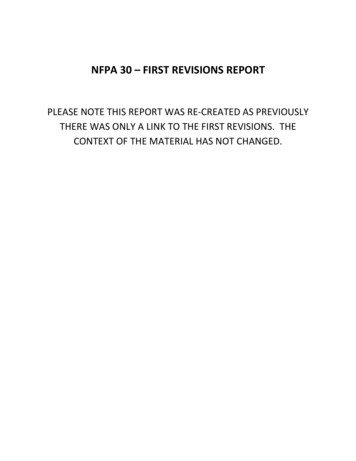
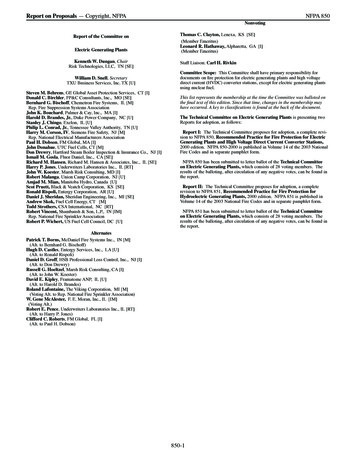
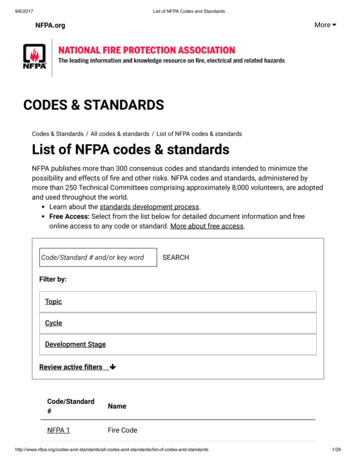
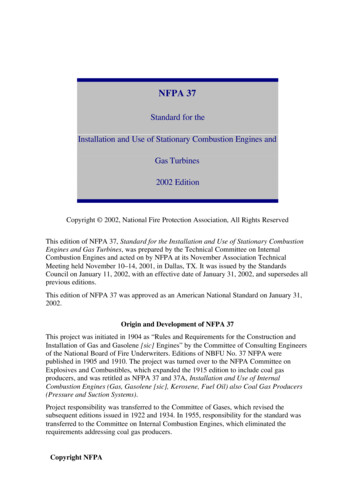
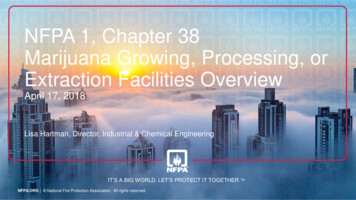
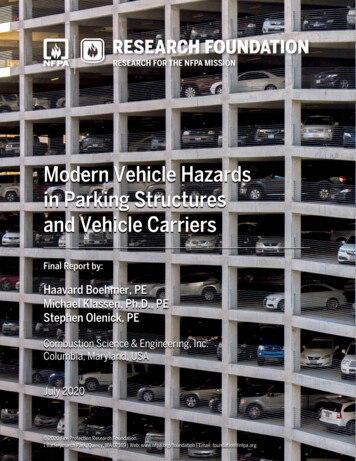
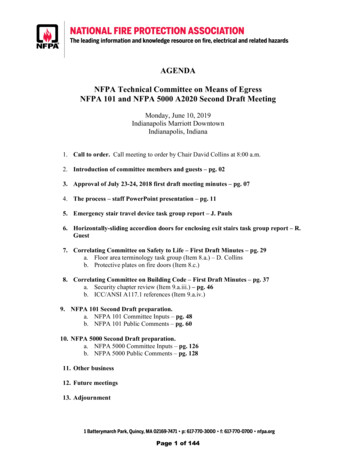
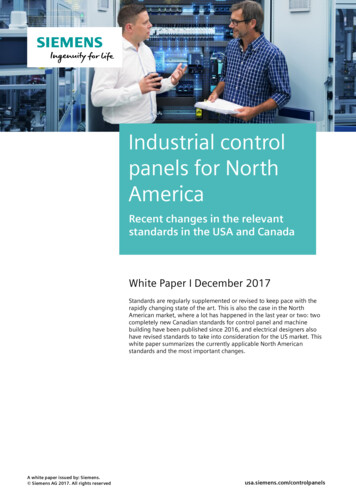
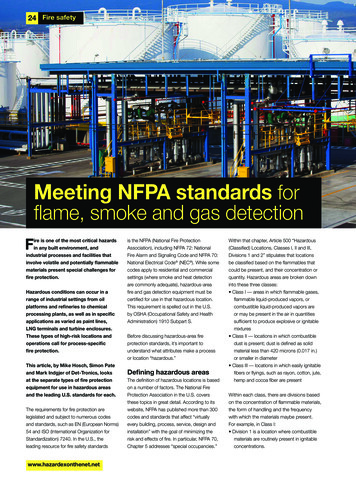
![First Revision No. 3-NFPA 497-2014 [ Chapter 2 ]](/img/5/497-a2016-eec-aaa-fd-frstatments.jpg)
